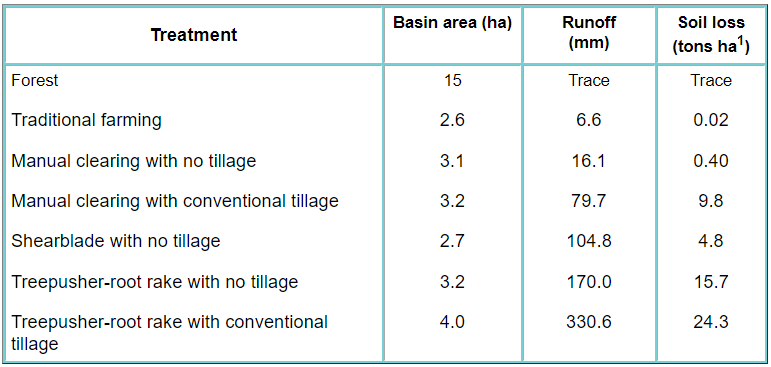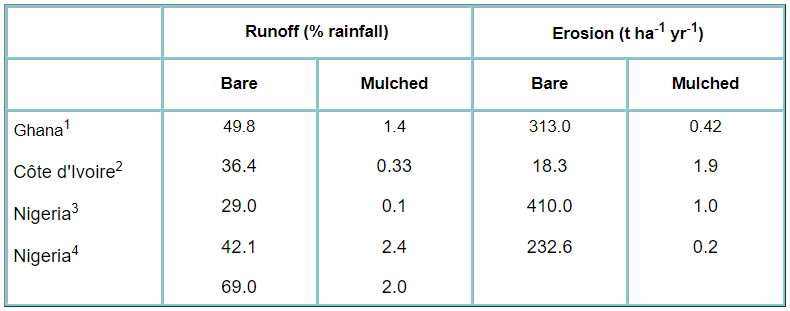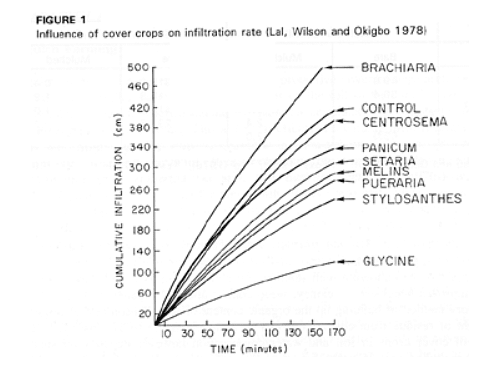Runoff Management - 1 | NABARD Grade A & Grade B Preparation - Bank Exams PDF Download
Rainfall runoff management techniques for erosion control and soil moisture conservation
Water availability often serves as a limiting factor for crop production in areas where irrigation is not accessible. Even in regions with high humidity and sub-humid conditions, where there's theoretically an excess of water, dry periods with water shortages are not uncommon. Implementing moisture conservation techniques in these regions often leads to positive outcomes. It's worth noting that more than 80% of the world's agricultural land is not irrigated. In Africa, where just slightly over 0.3% of the land is under irrigation according to FAO 1987 data, rainfed agriculture prevails. In such rainfed systems, the challenge lies not only in the irregular distribution of rainfall but also in the capacity of the soil to store and effectively utilize the rainfall in the root zone.
When rainfall occurs, it can take different paths:
- It can infiltrate and be stored in the root zone of the soil.
- It may pass downward to replenish groundwater.
- Some rainfall can be temporarily stored in surface depressions, where it may either infiltrate, evaporate, or runoff the surface.
These various pathways are accounted for in a field water balance equation (as described by Verplancke et al. in 1988):
P = S + D + M + U + SEdt
Here, P represents the received precipitation or rainfall, S accounts for surface runoff, D measures the increase in surface detention, M denotes the rise in soil water storage, U tracks the increase in groundwater storage, and SEdt sums up the total evaporation over a specified period of time.
Among these factors, runoff is a significant challenge in the management of water resources on rainfed croplands. It not only represents the loss of a potential water source but can also result in detrimental soil erosion.
Table 1: Effects of methods of deforestation and post-clearing management on erosion and runoff (Lal 1984)
Runoff occurs when the intensity of rainfall exceeds the soil's capacity to absorb and allow rainwater to pass through, which is a measure of the soil's ability to handle rainwater. Soils with a high infiltration capacity are less prone to runoff. This capacity depends on the water transmission characteristics and structural stability of the soil, as well as its ability to maintain continuous pores. These pores may be present due to the soil's coarse texture, good aggregation, or the activities of soil fauna, especially specific types of earthworms (as documented by De Vleeschauwer and Lal in 1981 and Aina in 1984). The rate and volume of runoff are also influenced by the intensity and quantity of rainfall, the initial soil moisture content, the terrain's relief, slope steepness, and aspect. These factors give rise to a range of runoff management challenges and conservation needs.
This paper compiles information on various runoff management techniques and examines their effectiveness in controlling erosion and conserving soil moisture. It provides examples from a variety of agro-ecological and climatic regions to increase awareness of the issue and equip planners and managers with valuable insights for making informed decisions.
Effects of runoff on erosion and soil and water resources
There is a strong correlation between the rate of runoff and the occurrence of erosion. Runoff water possesses the energy to dislodge soil particles through scouring and transport entrained soil materials either by suspending them or by pushing and rolling larger particles. Overland flow is a major contributor to erosion. Scouring-induced erosion accounts for less than 10% of the erosion process, with the majority being caused by the impact of raindrops. Secondary forms of erosion resulting from runoff's transporting effects are more destructive and are typically categorized as rill, gully, and stream channel erosion based on the increasing concentration of runoff and the degree of land damage. The erosive capacity of runoff is determined by its volume and velocity; as volume and velocity increase, so does the ability to dislodge soil particles and the capacity to transport them. Doubling the velocity of runoff increases its scouring and transport capacities exponentially (as per Shaxson et al. in 1977).
The consequences of runoff and erosion are detrimental to the quality and productivity of the affected land, both in terms of the eroded area and the land receiving soil material from higher ground. Erosion results in the loss of soil fertility due to topsoil and nutrient loss, organic matter reduction, clay loss, and subsequently, a decline in the soil's capacity to retain nutrients and water. It can also lead to soil surface compaction and sealing, resulting in reduced infiltration rates and increased runoff. In various parts of the world, erosion has severely impoverished the land and made it unsuitable for crop production. Erosion is a significant concern in the developing world as a whole. Runoff, wherever it occurs, leads to crop and fertilizer losses, soil moisture depletion, and reduced recharge capacity, often resulting in drought stress during crop production. As runoff accumulates in drainage lines, it can cause severe physical damage downstream, including the destruction of roads, bridges, buildings, and the formation of dangerous gullies. The impacts of excessive runoff are typically highlighted by the development of gully systems where erosion is concentrated. The deposition of particles carried by runoff leads to channel sedimentation, the siltation and contamination of dams and reservoirs with nutrients, pesticides, and toxic chemicals, and flooding and sedimentation of low-lying areas.
Most arable farming systems, particularly those involving complete deforestation, mechanical soil tillage, and continuous cultivation, disrupt the surface soil and expose it to the elements, making the land susceptible to significant runoff and erosion. For example, deforestation by mechanized systems followed by plow-based tillage can lead to substantial runoff and erosion (see Table 1). Under such systems, runoff and erosion can be considerable and severely limit crop production. The implementation of suitable runoff management techniques that improve water conservation and reduce erosion to acceptable levels can mitigate these adverse effects.
Runoff Management Techniques
Improvements in soil conditions and the regulation of soil-water levels to optimize crop production can be achieved through runoff management techniques. These techniques vary based on the specific situation, taking into account existing conservation issues, soil type, and ecological region.
The types of runoff management techniques can be categorized into those that:
- Enhance water absorption and storage in order to reduce runoff.
- Regulate the movement of water across the soil surface.
- Effectively manage excess rainfall as runoff or concentrate insufficient runoff.
Soil and water conservation are closely connected; methods that control and conserve water on hillsides also contribute to soil conservation and erosion control.
In arid and semi-arid regions, the choice of management is relatively straightforward: all rainfall must be retained through techniques that minimize storm-water runoff, improve soil infiltration, and increase the soil's water-holding capacity. In humid and sub-humid areas, striking a balance between soil and water conservation through runoff control and avoiding surface waterlogging is more challenging, with fewer straightforward options. Generally, runoff is best minimized by promoting the high infiltration of rainwater into the soil through biological conservation measures. When full infiltration is not possible, especially in regions with high-intensity storms or periods of poor crop cover, physical control measures can be used to hold water on the surface, allowing it time to penetrate the soil. These physical conservation measures involve land shaping, the construction of contour bunds, terraces, and ridges. They require careful technical design, supervision, proper construction, and ongoing maintenance. In contrast, biological methods involve various soil management and agronomic cultural practices that are typically part of profitable agriculture. These practices include appropriate land use and preparation, soil fertility maintenance, crop residue management, the use of cover crops, and suitable crop husbandry.
Extensive research on rainfall-runoff management and its impact on erosion and soil-water conservation has been accumulated over the years. Some successful practices are briefly described in the following section.
Practices that reduce runoff through improved infiltration capacity and soil transmission characteristics
Mulch Farming
Mulch farming is a method that involves maintaining a protective layer of vegetative residues, such as straw, maize stalks, palm fronds, and crop stubbles, on the soil surface continuously. This approach is particularly valuable in situations where it's challenging to establish a satisfactory plant cover during the times of the year when erosion risk is at its peak.
The advantages of mulching include:
- Protecting the soil surface from the impact of raindrops.
- Reducing flow velocity by introducing surface roughness.
- Enhancing soil infiltration capacity.
- Stimulating burrowing activity of certain earthworm species, such as Hyperiodrilus and Eudrilus, which improves water movement through the soil profile and reduces surface crusting, runoff, and enhances soil moisture storage in the root zone.
These benefits have been widely documented. Research has shown that mulching effectively reduces soil loss in both field and laboratory studies. For instance, studies have reported an annual reduction of 32% in water runoff due to mulching in humid regions. There have also been significant reductions in runoff and erosion observed in mulched fields on slopes. The amount of mulch required to maintain favorable soil conditions depends on factors like residue decomposition rate, climate, soil properties, terrain, and rainfall patterns. Studies have indicated that about 70% of the soil surface needs to be covered by mulch for it to be effective, with an optimal mulch rate of 4 to 6 tons per hectare in tropical regions. However, improvements in soil physical properties have been observed with mulch rates of up to 12 tons per hectare. Crop residue mulch has also shown benefits when plowed into the soil or applied after plowing.
The positive effects of mulching on soil and water conservation have been similarly reported in arid and semi-arid regions, although durable mulching materials may be less readily available in these areas with long dry seasons. However, other techniques like using cover crops, alley cropping, and no-tillage can provide usable mulch in such regions.
Soil Conditioners
Soil conditioners, which are emulsions of poly-functional polymers with oil or rubber bases, have been found to improve the size and stability of pore spaces in the soil and enhance its infiltration rate. These conditioners have the ability to create chemical bonds with clay minerals in the soil, resulting in the formation of aggregates. Effective temporary erosion control can be achieved by covering the entire soil surface, and this has been found to be comparable to the 70% coverage required when using mulches and plant covers for erosion control.
There are various soil conditioners available commercially, but they require further testing to determine appropriate application rates, the duration of their effectiveness, their impact on plant emergence, and the costs associated with their application. Tests on the use of soil conditioners for water runoff control have indicated that some bitumen treatments are effective for only a few rainstorms. While Poly-acrylamide conditioners can achieve high infiltration rates regardless of the size or distribution of aggregates, most emulsions, like asphalt and latex emulsions, require aggregates to be at least 2 mm in size and ideally greater than 5 mm to be effective.
Table 2: Residue mulch effect on runoff and soil erosion
1. Mensah-Bonsu and Obeng (1979);
2. Roose (1988);
3. Lal (1976);
4. Lawes (1966)
Cover Crops
The use of planted cover crops like Mucuna pruriens utilis, Pueraria phaseoloides, Centrosema pubescens, Setaria spp., Stylosanthes spp., and Glycine spp. provides an additional method for creating in situ mulch. Employing suitable cover crops during fallow periods helps in conserving soil water, enhancing water use efficiency, controlling weeds, and increasing soil organic matter. This approach is considered one of the most effective means of increasing the organic content in the soil. Research by Wilson in 1979 revealed that the dry weight of residue from cover crops can reach as much as 6.5 to 11 tons per hectare per year.
The effectiveness of cover crops in soil and water conservation depends on various species characteristics, including their ease of establishment, growth vigor, root depth, and the speed at which they provide surface coverage. Fallowing the land for one or two years with species like Mucuna pruriens utilis, Pueraria phaseoloides, and Centrosema pubescens has been shown to improve soil structure and infiltration capacity, as supported by research conducted by Pereira, Kannegieter, Okigbo, and Lal in various studies.
Alley Cropping
Alley cropping is an agro-forestry system that combines trees and shrubs with the cultivation of annual food crops (Kang et al. 1981; Vegara 1982). In this approach, arable crops are grown in the spaces between rows of planted woody shrubs or trees. These trees and shrubs are pruned during the cropping season to provide in situ green manure and to prevent shading of the crops. The effectiveness of this system in reducing erosion, surface runoff, and soil moisture loss depends on the appropriate selection of protective tree and shrub species. Promising results have been achieved in alley-cropping arable crops (such as maize) with species like Gliricidia and Leucaena. However, the ecological suitability of this system needs to be established for various eco-regions.
No-tillage Farming
Sound soil management is crucial for the success of soil conservation efforts because it ensures proper plant cover. No-tillage farming involves a seeding method in which crops are planted through a mulch of crop residues. It typically avoids mechanical or secondary tillage operations and relies on chemical weed control. No-tillage has been widely recognized for its positive impacts on soil and water conservation in humid and sub-humid climates, where it is well-suited (Table 3). The benefits include the conservation of soil moisture by reducing storm runoff, improved infiltration capacity, enhanced earthworm activity, decreased evaporation losses, reduced soil erosion, and the maintenance of high organic matter content. Some reports have indicated up to a fivefold reduction in runoff under no-tillage compared to conventional tillage (Lal 1976). The effectiveness of no-tillage farming in soil and water conservation is further enhanced when combined with the use of planted cover crops.
Table 3: Effects of tillage system on soil loss and runoff in Ghana (Mensah-Bonsu and Obeng 1979) No-tillage systems have shown reduced effectiveness on certain soils, particularly hydromorphic soils with inadequate internal drainage and those with compacted surface and subsoils. In some cases, the increasing costs of herbicides may make continuous no-tillage impractical, leading to the need for mechanical cultivation. Soils where no-tillage is less effective are often encountered in arid and semi-arid regions and include soil types like Ustropepts, Ustalfs, Alfic Eutrustox, and other Aridisols. These soils typically exhibit weak soil structure, low porosity, and poor infiltration rates. It's worth noting that the advantages of ploughing have also been demonstrated in the humid and sub-humid tropics (Lal 1984, 1986; Ogunremi et al. 1986).
No-tillage systems have shown reduced effectiveness on certain soils, particularly hydromorphic soils with inadequate internal drainage and those with compacted surface and subsoils. In some cases, the increasing costs of herbicides may make continuous no-tillage impractical, leading to the need for mechanical cultivation. Soils where no-tillage is less effective are often encountered in arid and semi-arid regions and include soil types like Ustropepts, Ustalfs, Alfic Eutrustox, and other Aridisols. These soils typically exhibit weak soil structure, low porosity, and poor infiltration rates. It's worth noting that the advantages of ploughing have also been demonstrated in the humid and sub-humid tropics (Lal 1984, 1986; Ogunremi et al. 1986).
Ploughing
Ploughing operations play a crucial role in maintaining soil porosity, particularly in compacted soils that restrict root growth and infiltration. Ploughing can aid in reducing runoff by promoting infiltration. For long-term effectiveness, it is essential that the soil aggregates remain stable and resistant to disintegration from the impact of raindrops. Various specialized tillage practices, including soil inversion, chiselling, subsoiling, and deep tillage (for soils with impediments within the rooting depth), have been found to be beneficial for enhancing surface retention, storage, infiltration, root development, and preventing soil compaction (Ofori and Nandy 1969; Ofori 1973; Lal 1984; Ogunremi et al. 1986).
The effectiveness of ploughing for soil and water conservation is influenced by factors such as the timing of the ploughing operation, the soil moisture content, and the frequency of ploughing. Recent studies underscore the importance of cultivating when soil conditions, especially soil moisture, are optimal to avoid structural damage and smearing (Davies 1974; Spoor 1975). The adverse impact of conventional tillage practices can be reduced by minimizing the number of passes on the land. This can be achieved by cultivating only the narrow strips of land necessary for seedbeds, leaving wider untilled zones (strip zone tillage), carrying out tillage while retaining a mulch on the ground (mulch tillage), or consolidating multiple activities into a single pass (minimum tillage) as seen in plough-plant operations.
|
847 videos|1297 docs|420 tests
|





















